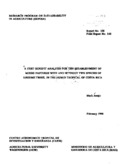| dc.contributor.author | Joenje, M. | |
| dc.date.accessioned | 2014-10-17T05:31:45Z | |
| dc.date.available | 2014-10-17T05:31:45Z | |
| dc.date.issued | 1996 | es_ES |
| dc.identifier | 348966 | es_ES |
| dc.identifier.uri | https://repositorio.catie.ac.cr/handle/11554/35 | |
| dc.description | 51 pág, 3 ilus, 9 tab, 39 ref. También como serie: Field Report - CATIE. Atlantic Zone Programme no. 145 | es_ES |
| dc.description.abstract | Animal production from native pastures is low in the Atlantic Zone of Costa Rica. Research has shown that meat production can be increased up to six times, by replacing the native grass vegetation with a mixture of the grass B. brizantha and the legume A. pintoi (BA mixtures). In an ongoing experiment, this mixture is grown in combination with two legume trees (Erythrina berteroana and Gliricidia sepium) (Silvopastoral system) and tested for its production and persistence under grazing. In this study an economic analysis is performed of establishing BA mixtures with and without trees. The costs for establishment of the BA mixtures were US 397/ha when the land was prepared manually and US 465/ha when the land was prepared mechanically. Establishment costs for the silvopastoral system were US 967/ha. This large difference in costs was attributed to the high labor costs for preparation and seeding of tree legumes (421 hours/ha). Maintenance costs of the BA mixture are restricted to weed control, requiring US 25/ha/yr. For the silvopastoral system maintenance costs consist of weed control and pruning of legume trees three times a year, requiring US 96/ha/yr. Gross meat production was calculated to b US 610/ha/yr for BA mistures and US 671/ha/yr for the silvopastoral system, which meant an increase in production of 330 percent and 380 percent respectively compared to production from native pastures (US 139/ha/yr). The net benefits of the BA mixtures, however, are higher than that of the silvopastoral system (US 585/ha/yr vs. US 575/ha/yr). Significant differences were found regarding the Internal Rate of Return (IRR) of the two systeMON which was 231 percent for the BA mixtures and 38 percent for the silvopastoral system respectively. It was concluded that establishing BA mixtures is an attractive method to improve animal production. Silvopastoral systeMON as described in this study, even though they do increase animal production, are not an attractive investment, since the IRR is below 50 percent. On the other hand, in countries where labor costs are not as high as Costa Rica, the system may be an attractive improvement measure, since its high costs are mainly caused by high labor costs. Moreover, the ecological and conservational benefits of incorporating trees in a grazing system, may form an important motive for the establishment of such systeMON, even though they cannot easily be expressed in currency terMON. To serve these ecological and conservational functions, different planting techniques and densities should be developed. | es_ES |
| dc.language.iso | en | es_ES |
| dc.publisher | CATIE, Turrialba (Costa Rica). Proyecto CATIE/AUW/MG Agricultural University Wageningen, Wageningen (Países Bajos) Ministerio de Agricultura y Ganadería, San José (Costa Rica) | es_ES |
| dc.relation.ispartof | Report - Proyecto CATIE/AUW/MAG Research Program on Sustainability in Agriculture (REPOSA) / CATIE-AUW-MAG ; número 100 | |
| dc.subject | COSTA RICA | es_ES |
| dc.subject | BRACHIARIA BRIZANTHA | es_ES |
| dc.subject | ARACHIS PINTOI | es_ES |
| dc.subject | GLIRICIDIA SEPIUM | es_ES |
| dc.subject | ERYTHRINA LEGUMINOSAS | es_ES |
| dc.subject | FORRAJERAS | es_ES |
| dc.subject | ESTABLECIMIENTO DE PLANTAS | es_ES |
| dc.subject | PASTIZALES | es_ES |
| dc.subject | CULTIVO MIXTO | es_ES |
| dc.subject | FITOMEJORAMIENTO | es_ES |
| dc.subject | TROPICOS HUMEDOS | es_ES |
| dc.subject | ANALISIS DE COSTOS Y BENEFICIOS | es_ES |
| dc.title | A cost-benefit analysis for the establishment of mixed pastures with and without two species of legume trees, in the humid tropical of Costa Rica | es_ES |
| dc.type | Libro | es_ES |


